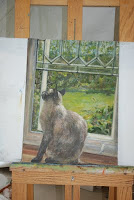
When you follow Marie Saretsky around her garden, she effuses with enthusiasm as she talks about the 20-year dream that finally came to life this year.
Marie and husband Jerry Saretsky live on a 14-acre farm just outside of Burr. Until this year, she used the plot of land, now been transformed into a meditative garden with curving pathways and lush vegetation, to grow flowers for her dried flower business, Flowers of Dellwood Creek, www.dellwoodcreek.com.
Prior to that, it was a wheat field.
“We broke the soil 29 years ago,” said the pixie-like woman, “the year my son was born.” That was when her long journey began, the journey that led her to discover the direction her garden was meant to grow.
Saretsky has always been interested in gardening, and making use of what the land offers. From her dried flowers, she has created a myriad of small crafts, such as floral arrangements, homemade paper with pressed flowers, handmade cards, herbal sachets; the list goes on.
But over time, her vision changed, and she became interested in something she refers to as intuitive gardening.
“It can be many things, a garden,” explained Saretsky, “There’s the language of the flowers, and there’s the historical symbolism that goes with flowers. When I give garden tours, there is no end to the topics you can have in a garden.”
Or, she added, you can just walk quietly through it and enjoy.
To see the garden today, it’s hard to believe that in the spring the pathways weren’t yet laid down.
At that point, according to Saretsky, she didn’t know whether the garden was really going to go ahead. Then she had some volunteer help through the WWOOF organization (World Wide Opportunities on Organic Farms); a couple of “Woofers” came from France and completely pruned the lilac hedge that borders one long wall of the garden. That is when Saretsky started to believe it was going to happen.
A short time later, another two girls who had seen her ‘blurb’ on the WWOOF website came from the United States to help. Together they got the paths put in. But it was a case of “three steps forward and two steps back”, for when the rains came in the spring, she was left with a garden full of weeds.
Today, bright blue delphiniums stand nearly six feet tall near the north “wall” of her garden, while the east wall is covered with yellow lilies.
“The garden has four walls,” she explained, “for the four directions. The east wall isn’t finished yet, but when it is done, there will be a mass of yellow in the middle of the lattice work. It symbolizes the rising sun, which is the new beginnings of a new day.”
Plants of all kinds line the curving paths, which, Saretsky insisted, are meant to slow people down as they wander through the garden.
“Walking through a garden should be relaxing.” she said.
Leggy garlic stems sway above Lady’s Mantle, while a row of tomato plants stand proudly next to a clump of sunflowers, three feet high. Further along the pathway, onions border the edge in front of a row of calendula.

“It’s a mixed garden, with both vegetables and flowers, the way we use to garden,” noted Saretsky. “Today there is a trend toward monocultures, but it didn’t used to be like that.”
At the centre of her garden, on a little stone patio, a wooden table and chairs invite the visitor to sit down and contemplate. The quirky effect of the brightly painted furniture, each item a different colour, adds to the garden’s charm.
Saretsky loves the idea of sharing her garden and can think of many ways people could come and enjoy the space. It could be a place of inspiration for artists, a place of quiet meditation for yogis, a place for people to commune with nature or a place for those who want to learn more about intuitive gardening.

